The Potential of Recycling and Reusing Waste Materials in Underground Construction: A Review of Sustainable Practices and Challenges
Abstract
:1. Introduction
- –
- –
- Optimizing material usage: This entails minimizing the use of virgin materials and maximizing the reuse and recycling of existing materials [9].
- –
- Protecting the natural and built environments: This includes minimizing disturbance to ecosystems, preserving biodiversity, and ensuring the long-term integrity of the surrounding infrastructure [11].
- –
- Achieving whole-life cost-effectiveness: This involves considering the long-term costs and benefits of the project, including maintenance and operational expenses [9].
2. Recycling of Tunnel Excavation Materials
2.1. On-Site Reusing
2.1.1. Reuse as Raw Materials in Grouting
2.1.2. Reuse as Raw Materials in Soil Conditioning


2.1.3. Reuse as Aggregates in Concrete Production
2.2. Off-Site Reusing
2.2.1. Reuse as Sub-Base for Road Pavements
2.2.2. Reuse as Refilling Materials
2.2.3. Reuse as Value-Added Materials in Other Industries
2.2.4. Reuse as Vegetation Reclamation Materials
3. Recovery and Reuse of False Segmental Tunnel Linings
4. Utilization of Other Industries’ Waste in Underground Construction
4.1. Use of Recycled Materials for Thermal Insulation
4.2. Use of Recycled Materials for Fire Protection
4.3. Use of Construction and Demolition Waste as Refilling Materials in Underground Mining
4.4. Use of Recycled Materials as Aggregates in Tunnel Linings
4.5. Use of Industrial Solid Wastes in Grouting
4.6. Use of Recycled Materials as Tunnel Lining Reinforcement
5. Application of Sustainable and Eco-Friendly Methods and Materials in Underground Construction
6. Conclusions
- –
- On-site reuse: This review highlighted the successful implementation of on-site reuse of TEM for various applications, including backfill, grouting, soil conditioning, and concrete production. Case studies from projects like the S1 Vienna and the Nanjing Metro Line 10 Tunnel demonstrated the feasibility and benefits of these approaches.
- –
- Off-site reuse: The potential for off-site reuse of TEM, including road bases, refilling works, and the production of value-added materials like aggregates and construction products, was explored.
- –
- Waste utilization: Utilizing other industrial and construction wastes in underground works shows potential to substitute conventional materials. Applications such as for thermal insulation, fire protection, tunnel lining, backfilling, or grouting materials demonstrate comparable engineering properties with reduced impacts.
- –
- Green methods: One aspect of green tunneling methods, green grouting, ensures excavation safety while preserving surrounding environments. Furthermore, the ecological tunnel concept, including green lining and green lighting, presents a promising new approach for integrating ecological and sustainability principles across the entire lifecycle of a tunnel infrastructure.
- –
- Technological advancements: The review discussed the role of technological advancements in facilitating sustainable practices, such as real-time analysis of spoil properties, advanced TBMs with sorting mechanisms, and mobile processing plants. These technologies contribute to improved efficiency, waste reduction, and material recovery. For instance, the implementation of TBMs in the Gotthard Base Tunnel in Switzerland demonstrated a reduction in excavation time and environmental impact.
- –
- Standardization and assessment: Further research is needed to refine and standardize the assessment of recycled material properties and develop standardized guidelines for their use in various applications. This will enhance confidence in the performance and reliability of recycled materials.
- –
- Multi-stakeholder collaboration: Achieving coordinated multi-stakeholder adoption, including collaboration between contractors, suppliers, regulatory bodies, and research institutions, is crucial for maximizing the impact of sustainable practices and accelerating the transition towards a more sustainable underground construction industry.
- –
- Lifecycle assessment: Conducting comprehensive life cycle assessments of different sustainable practices is essential to quantify their environmental and economic benefits, enabling informed decision making and promoting the adoption of the most effective approaches.
Author Contributions
Funding
Institutional Review Board Statement
Informed Consent Statement
Data Availability Statement
Conflicts of Interest
References
- Shreekant, R.L.; Aruna, M.; Vardhan, H. Utilisation of Mine Waste in the Construction Industry-A Critical Review. Int. J. Earth Sci. Eng. 2016, 9, 182–195. [Google Scholar]
- Chen, X.; Huang, M.; Bai, Y.; Zhang, Q.-B. Sustainability of Underground Infrastructure—Part 1: Digitalisation-Based Carbon Assessment and Baseline for TBM Tunnelling. Tunn. Undergr. Space Technol. 2024, 148, 105776. [Google Scholar] [CrossRef]
- National Research Council. Lifecycle Sustainability, Costs, and Benefits of Underground Infrastructure Development. In Underground Engineering for Sustainable Urban Development; The National Academies Press: Washington, DC, USA, 2013. [Google Scholar]
- Illescas Martínez, C. Analysis of Improvements in Recycling Tunnel Spoils: Case Study: Brenner Base Tunnel; Universidad Politécnica de Cartagena: Cartagena, Spain, 2020. [Google Scholar]
- Hlad, C. Sustainable Design Strategies for Tunneling Projects. Underground Construction; 2011. Vol. 66, No. 11. Magazine Article. Available online: https://undergroundinfrastructure.com/magazine/2011/july-2011-vol-66-no-7/features/sustainable-design-strategies-for-tunneling-projects (accessed on 2 June 2024).
- Katsumi, T. Soil Excavation and Reclamation in Civil Engineering: Environmental Aspects. Soil. Sci. Plant Nutr. 2015, 61, 22–29. [Google Scholar] [CrossRef]
- Ministry of Land, Infrastructure, and Transport (MLIT). Investigation Results of Construction By-Products in 2012; Ministry of Land, Infrastructure, and Transport (MLIT): Tokyo, Japan, 2014.
- Voit, K.; Murr, R.; Cordes, T.; Zeman, O.; Bergmeister, K. Tunnel Spoil Recycling for Concrete Production at the Brenner Base Tunnel in Austria. Struct. Concr. 2020, 21, 2795–2809. [Google Scholar] [CrossRef]
- National Research Council. Innovative Underground Technology and Engineering for Sustainable Development. In Underground Engineering for Sustainable Urban Development; The National Academies Press: Washington, DC, USA, 2013. [Google Scholar]
- Dou, S.; Zhu, H.; Wu, S.; Shen, Y. A Review of Information Technology Application in Reducing Carbon Emission: From Buildings to Tunnels. J. Clean. Prod. 2024, 452, 142162. [Google Scholar] [CrossRef]
- National Research Council. Health and Safety Underground. In Underground Engineering for Sustainable Urban Development; The National Academies Press: Washington, DC, USA, 2013. [Google Scholar]
- ITA Working Groups 14 and 15. Handling, Treatment and Disposal of Tunnel Spoil Materials; Report No. 21; International Tunnelling and Underground Space Association: Lausanne, Switzerland, April 2019; Available online: https://about.ita-aites.org/component/k2/download/1786_89ac66ec071317e24c8b64acafde0ac7 (accessed on 2 June 2024).
- Duarte, G.; Gomes, R.C.; de Brito, J.; Bravo, M.; Nobre, J. Economic and Technical Viability of Using Shotcrete with Coarse Recycled Concrete Aggregates in Deep Tunnels. Appl. Sci. 2020, 10, 2697. [Google Scholar] [CrossRef]
- Huber, H.; Kratochwill, R.; Otto, R. Use of Recycled Material for Segments and Inner Lining—First Experience of on-Site Processing on KAT 2. Geomech. Tunnelbau 2013, 6, 661–668. [Google Scholar] [CrossRef]
- Maria Seidler, I. Reuse of Tunnel Excavation Material-Real-Time Measurements and Decision-Making on the Construction Site of Research@ZaB-Zentrum Am Berg-an Underground Research Facility in Eisenerz, Austria. Master’s Thesis, Montanuniversitaet Leoben, Leoben, Austria, 2018. [Google Scholar]
- Tran, T.H.; Le, M.L. Tunnel Muck Recycling for Road Construction—A Case Study in Vietnam. In Proceedings of the 4th Congrès International de Géotechnique—Ouvrages-Structures, Ho Chi Minh City, Vietnam, 26–27 October 2018; Springer: Berlin/Heidelberg, Germany, 2018; Volume 8, pp. 1153–1163. [Google Scholar]
- Schröfelbauer, T.; Schreitl, B.; Kitzler, C. S1 Danube-Lobau Tunnel—Recycling of Tunnel Spoil Material. Geomech. Tunnelbau 2009, 2, 633–642. [Google Scholar] [CrossRef]
- Ma, J.; Zhang, G.; Ren, F. Study on the Characteristics and Reduction Measures of Construction Waste Generated in Subway Engineering. In Proceedings of the IOP Conference Series: Earth and Environmental Science, Wuhan, China, 24–25 April 2020; IOP Publishing Ltd.: Bristol, UK, 2020; Volume 555. [Google Scholar]
- Kwan, J.C.T.; Jardine, F.M. Ground Engineering Spoil: Practices of Disposal and Reuse. Eng. Geol. 1999, 53, 161–166. [Google Scholar] [CrossRef]
- Tauer, A.; Posch, H.; Kager, M.; Schubel, D. Recycling or Landfill—Experience Based on the Example of Koralm Tunnel, Contract KAT2 from Design to Construction. Geomech. Tunnelbau 2017, 10, 700–710. [Google Scholar] [CrossRef]
- Zhang, N.; Zhang, H.; Schiller, G.; Feng, H.; Gao, X.; Li, E.; Li, X. Unraveling the Global Warming Mitigation Potential from Recycling Subway-Related Excavated Soil and Rock in China Via Life Cycle Assessment. Integr. Environ. Assess. Manag. 2021, 17, 639–650. [Google Scholar] [CrossRef]
- Krenžel, V.; Šancer, J.; Široký, T.; Střasáková, A. The Potential Reuse of the Material Generated during Tunnelling. In Proceedings of the 4th International Conference on Advances in Environmental Engineering, Ostrava, Czech Republic, 20–22 November 2023. [Google Scholar]
- Oggeri, C.; Fenoglio, T.M.; Vinai, R. Tunnel Spoil Classification and Applicability of Lime Addition in Weak Formations for Muck Reuse. Tunn. Undergr. Space Technol. 2014, 44, 97–107. [Google Scholar] [CrossRef]
- Danzer, M. Waste Law Framework for the Recovery of Material Excavated from Tunnels. Geomech. Tunnelbau 2014, 7, 411–418. [Google Scholar] [CrossRef]
- Posch, H.; Murr, R.; Huber, H.; Kager, M.; Kolb, E. Tunnel Excavation—The Conflict between Waste and Recycling through the Example of the Koralm Tunnel, Contract KAT2. Geomech. Tunnelbau 2014, 7, 437–450. [Google Scholar] [CrossRef]
- Entacher, M.; Resch, D.; Galler, R.; Reichel, P. Recycling of Tunnel Spoil—Laws Affecting Waste from Mining and Tunnelling. Geomech. Tunnelbau 2011, 4, 692–701. [Google Scholar] [CrossRef]
- Haas, M.; Galler, R.; Scibile, L.; Benedikt, M. Waste or Valuable Resource—A Critical European Review on Re-Using and Managing Tunnel Excavation Material. Resour. Conserv. Recycl. 2020, 162, 105048. [Google Scholar] [CrossRef]
- European Parliament and Council of the European Union Directive 2008/98/EC on Waste (Waste Framework Directive). Available online: https://eur-lex.europa.eu (accessed on 25 May 2024).
- Federal Law Gazette I No. 102/2002 Waste Management Act (AWG 2002) 2002. Available online: https://www.ris.bka.gv.at/defaultEn.aspx (accessed on 2 June 2024).
- Austrian Federal Ministry of Agriculture, Forestry, Regions and Water Management. Federal Waste Management Plan 2017; Austrian Federal Ministry of Agriculture, Forestry, Regions and Water Management: Vienna, Austria, 2017. [Google Scholar]
- Reichel, P. Tunnel Spoil: Tipping or the End of the Definition as Waste. Geomech. Tunnelbau 2014, 7, 419–427. [Google Scholar] [CrossRef]
- Chen, R.; Li, L.; Yang, K.; Ren, F.; Xi, C.; Lin, Y.; Zheng, H. Quantitative Methods for Predicting Underground Construction Waste Considering Reuse and Recycling. Environ. Sci. Pollut. Res. 2022, 29, 3394–3405. [Google Scholar] [CrossRef]
- Oggeri, C.; Vinai, R. Tunnelling Muck Classification: Definition and Application. In Proceedings of the World Tunnel Congress 2017—Surface challenges—Underground Solutions, Bergen, Norway, 9–15 June 2017. [Google Scholar]
- Lei, X.; Sun, D.; Liu, K.; Jia, Q.; Li, D.; Feng, Y. Technical Summary of Tunnel Mud Pumping Treatment and a Method of Pressure Reduction by Water Release. Appl. Sci. 2023, 14, 276. [Google Scholar] [CrossRef]
- Starke, R. Tunnel Excavation Material and Circular Economy in Austria—General Requirements, Current Situation and Further Developments from the Waste Management Perspective. Geomech. Tunnelbau 2022, 15, 783–791. [Google Scholar] [CrossRef]
- Erben, H.; Galler, R. Tunnel Spoil—New Technologies on the Way from Waste to Raw Material. Geomech. Tunnelbau 2014, 7, 402–410. [Google Scholar] [CrossRef]
- Xie, Y.; Zhang, C.; Yang, J.; Fu, J.; Xiao, C.; Zhan, Y. Research and Prospect on Technology for Resource Recycling of Shield Tunnel Spoil. Tunn. Constr. 2022, 42, 188–207. [Google Scholar]
- Sharghi, M.; Chakeri, H.; Ozcelik, Y. Investigation into the Effects of Two Component Grout Properties on Surface Settlements. Tunn. Undergr. Space Technol. 2017, 63, 205–216. [Google Scholar] [CrossRef]
- Peila, D.; Borio, L.; Pelizza, S. The Behaviour of a Two-Component Backfilling Grout Used in a Tunnel-Boring Machine. ACTA Geotech. Slov. 2011, 8, 5–15. [Google Scholar]
- Luo, G.; Xiao, C.; Liu, Y.; Feng, K.; Ren, Q. Research on the Reuse of Discharged Soil from EBP Shield Tunnels in Synchronous Grouting Material. Adv. Civ. Eng. 2022, 2022, 8102488. [Google Scholar] [CrossRef]
- Zhang, J.; Lu, S.; Feng, T.; Yi, B.; Liu, J. Research on Reuse of Silty Fine Sand in Backfill Grouting Material and Optimization of Backfill Grouting Material Proportions. Tunn. Undergr. Space Technol. 2022, 130, 104751. [Google Scholar] [CrossRef]
- Zhang, C.; Yang, J.; Xie, Y.; Fu, J.; Wang, S.; Yin, J. Utilization of Tunnel Spoils as a Lightweight Filling Material for the Voids behind Tunnel Excavation Contour. J. Clean. Prod. 2022, 372, 133559. [Google Scholar] [CrossRef]
- Movilla-Quesada, D.; Vega-Zamanillo, Á.; Castro-Fresno, D.; Calzada-Pérez, M.A.; Raposeiras, A.C. Sustainability in Construction Works: Reuse of Sludge from Tunnel Boring in Lime Mortars. Appl. Clay Sci. 2015, 114, 402–406. [Google Scholar] [CrossRef]
- Cui, Y.; Tan, Z.; Wang, J.; Shi, Y.; Bai, Z.; Cao, Y. Research on Reuse of Shield Soil Dregs on Synchronous Grouting Materials and Its Application. Constr. Build. Mater. 2023, 408, 133700. [Google Scholar] [CrossRef]
- Chen, X.; Zhu, W.; Wang, R.; Min, F.; Wei, D. Application of Waste Sand in Backfilling for Tunneling Projects, Particularly the Case Study on the Weisanlu River Crossing Tunnel in Nanjing. Tunn. Constr. 2015, 35, 1176–1181. [Google Scholar]
- Zhou, S.; Li, X.; Ji, C.; Xiao, J. Back-Fill Grout Experimental Test for Discharged Soils Reuse of the Large-Diameter Size Slurry Shield Tunnel. KSCE J. Civ. Eng. 2017, 21, 725–733. [Google Scholar] [CrossRef]
- Zhang, C.; Yang, J.; Fu, J.; Wang, S.; Yin, J.; Xie, Y. Recycling of Discharged Soil from EPB Shield Tunnels as a Sustainable Raw Material for Synchronous Grouting. J. Clean. Prod. 2020, 268, 121947. [Google Scholar] [CrossRef]
- Zhang, C.; Chen, K.; Yang, J.; Fu, J.; Wang, S.; Xie, Y. Reuse of Discharged Soil from Slurry Shield Tunnel Construction as Synchronous Grouting Material. J. Constr. Eng. Manag. 2022, 148, 04021193. [Google Scholar] [CrossRef]
- Joyprakash, N.; Kumar, J.A.; Singh, T.N. A Comprehensive Review of Grouts: Unraveling Biogrout Technologies for Environmental Sustainability and Limitations. J. Hazard. Toxic. Radioact. Waste 2024, 28, 03124001. [Google Scholar] [CrossRef]
- Ciardi, G.; Vannucchi, G.; Madiai, C. Effects of Colloidal Silica Grouting on Geotechnical Properties of Liquefiable Soils: A Review. Geotechnics 2021, 1, 460–491. [Google Scholar] [CrossRef]
- ITA. WG Mechanized Tunnelling. In Recommendations and Guidelines for Tunnel Boring Machines (TBMs); WORKING GROUP No. 14; ITA-AITES: Genoa, Italy, 2000. [Google Scholar]
- Ganeshan, V.; Ow, C.N.; Marotta, M.; Yoshimitsu, A.; Jee, Y.Y. Grouting and Its Application in Tunneling. In Proceedings of the International Conference on Deep Excavation, Singapore, 10–12 November 2008. [Google Scholar]
- Wang, D.; Min, F.; Lyu, H.; Chen, J.; Wang, B.; Zhang, J. Recycling Waste Sand from Slurry Shield Tunneling: A Sustainable Filter Aid for Waste Slurry Dehydration. J. Clean. Prod. 2023, 383, 135387. [Google Scholar] [CrossRef]
- GB/T 50123-2019; Standard for Geotechnical Testing Method. China Planning Press: Beijing, China, 2019.
- Wu, S.L.; Zhu, W.; Liu, J.M.; Li, Y.Q.; Cui, Y.; Wang, F.L.; Zhao, D. Change Laws of Mud Property and Problems in Typical Environmental Dredging Treatment Projects. Yantu Gongcheng Xuebao/Chin. J. Geotech. Eng. 2019, 41, 2290–2296. [Google Scholar] [CrossRef]
- Baghali, H.; Chakeri, H.; Sharghi, M.; Dias, D. Effect of Soil Moisture and Granulometry on Soil Conditioning for EPB-TBM Tunneling: Case Study. J. Test. Eval. 2020, 49, 355–371. [Google Scholar] [CrossRef]
- Pourmand, S.; Chakeri, H.; Sharghi, M.; Bonab, M.H.; Ozcelik, Y. Laboratory Studies on Soil Conditioning of Sand in the Mechanized Tunneling. J. Test. Eval. 2020, 48, 3658–3672. [Google Scholar] [CrossRef]
- Wang, X.; Zhao, W.; Wang, Z.; Wang, Z.; Sun, D.; Tang, X. Recycling the Discharged Soil from EPBS Tunnels as a Soil Conditioner and Its Rheological Behaviors. J. Clean. Prod. 2023, 418, 138224. [Google Scholar] [CrossRef]
- GB 50652-2011; Code for Risk Management of Underground Works in Urban Rail Transit. Chinese Standard: Beijing, China, 2011.
- Luo, Q.; Liu, P.; Wu, M. Re-Using Excavated Rock from Underground Tunneling Activities to Develop Eco-Friendly Ultrahigh Performance Concrete. Case Stud. Constr. Mater. 2024, 20, e02867. [Google Scholar] [CrossRef]
- Murr, R.; Cordes, T.; Hofmann, M.; Bergmeister, K. Autarkic Aggregate Supply with Recycled Tunnel Spoil at the Brenner Base Tunnel. In Tunnels and Underground Cities. Engineering and Innovation Meet Archaeology, Architecture and Art; CRC Press: Boca Raton, FL, USA, 2019. [Google Scholar]
- Dengg, F.; Zeman, O.; Voit, K.; Bergmeister, K. Fastening Application in Concrete Using Recycled Tunnel Excavation Material. Struct. Concr. 2018, 19, 374–386. [Google Scholar] [CrossRef]
- Voit, K.; Kuschel, E. Rock Material Recycling in Tunnel Engineering. Appl. Sci. 2020, 10, 2722. [Google Scholar] [CrossRef]
- Duarte, G.; Bravo, M.; de Brito, J.; Nobre, J. Mechanical Performance of Shotcrete Produced with Recycled Coarse Aggregates from Concrete. Constr. Build. Mater. 2019, 210, 696–708. [Google Scholar] [CrossRef]
- Ma, R.; Zhang, L.; Chen, Z.; Miao, C.; Zhang, C.; Fan, T.; Zhang, J.; Qian, X. Utilization of Solid Waste from Tunnel Excavation as Manufactured Sand with Different Lithology and Pre-Washing Process for Preparation of Eco-Friendly Ultra-High Performance Concretes: Properties and Microstructural Analysis. J. Build. Eng. 2024, 82, 108252. [Google Scholar] [CrossRef]
- Mlinar, C.; Sempelmann, F.; Koch, G.; Steiner, M.; Kubin, F. Tunnel Spoil as a Source of Raw Materials for an Autobahn—Sustainable Reuse of Resources through the Example of the S 10. Geomech. Tunnelbau 2014, 7, 428–436. [Google Scholar] [CrossRef]
- Bellopede, R.; Marini, P. Aggregates from Tunnel Muck Treatments. Properties and Uses. Physicochem. Probl. Miner. Process 2011, 47, 259–266. [Google Scholar]
- Resch, D.; Lassnig, K.; Galler, R.; Ebner, F. Tunnel Excavation Material—High Value Raw Material. Geomech. Tunnelbau 2009, 2, 612–618. [Google Scholar] [CrossRef]
- Collepardi, M. Scienza e Tecnologia Del Calcestruzzo; Hoepli Editore: Milan, Italy, 1991. [Google Scholar]
- Haid, H.G.; Hammer, H. Katzenbergtunnel—Umwelttechnische Und Genehmigungsrechtliche Randbedingungen Für Die Verwertung von Tunnelausbruchmaterial. Geomech. Tunnelbau 2009, 2, 643–651. [Google Scholar] [CrossRef]
- Gertsch, L.; Fjeld, A.; Nilsen, B.; Gertsch, R. Use of TBM Muck as Construction Material. Tunn. Undergr. Space Technol. 2000, 15, 379–402. [Google Scholar] [CrossRef]
- Infrastructure Magazine Western Sydney International Airport Progress: An Airport for the Future. Available online: https://infrastructuremagazine.com.au/2023/09/06/western-sydney-international-airport-progress-an-airport-for-the-future/ (accessed on 21 March 2024).
- Sydney Metro Co. Metro Sandstone to Help Build Sydney’s New Airport. Available online: https://www.sydneymetro.info/article/metro-sandstone-help-build-sydneys-new-airport (accessed on 21 March 2024).
- Zhang, Y.; Liu, J.; Cheng, M.; Li, Y.; Huang, J.; Jing, Z. Hydrothermal Solidification of Underground Construction Wastes into Building Materials: Waste Slurry Recycling, Industrial Application and Evaluation. J. Clean. Prod. 2023, 426, 139091. [Google Scholar] [CrossRef]
- Tazzini, A.; Gambino, F.; Casale, M.; Dino, G.A. Managing Marble Quarry Waste: Opportunities and Challenges for Circular Economy Implementation. Sustainability 2024, 16, 3056. [Google Scholar] [CrossRef]
- Shi, X.; Kou, L.; Liang, H.; Wang, Y.; Li, W. Evaluating Carbon Emissions during Slurry Shield Tunneling for Sustainable Management Utilizing a Hybrid Life-Cycle Assessment Approach. Sustainability 2024, 16, 2702. [Google Scholar] [CrossRef]
- Ding, G.K.C. 3-Life Cycle Assessment (LCA) of Sustainable Building Materials: An Overview. In Eco-efficient Construction and Building Materials; Pacheco-Torgal, F., Cabeza, L.F., Labrincha, J., de Magalhães, A., Eds.; Woodhead Publishing: Sawston, UK, 2014; pp. 38–62. ISBN 978-0-85709-767-5. [Google Scholar]
- Ding, J.; Li, Y.; Liu, J.; Qi, G.; Liu, Q.; Dong, L. Life Cycle Assessment of Environmental Impacts of Cold and Hot Break Tomato Paste Packaged in Steel Drums and Exported from Xinjiang, China. Env. Impact Assess. Rev. 2023, 98, 106939. [Google Scholar] [CrossRef]
- Green Vision Green Vision Helps CRL Repurpose Reinforced Concrete TBM Tunnel Sections. Available online: https://greenvisionrecycling.co.nz/news/green-vision-helps-crl-repurpose-tbm-tunnel-sections (accessed on 21 March 2024).
- City Rail Link Ltd. CRL Ltd. HSES Report 2022; City Rail Link Ltd.: Auckland, New Zealand, 2023. [Google Scholar]
- Megri, A.C. An Alternative Procedure to Recycling Plastic Waste for Basement Underground Thermal Insulation in Cold Climate Buildings. Int. Soc. Waste Manag. Air Water 2010, 10, 44–53. [Google Scholar]
- Hanson, J.L.; Asce, M.; Kopp, K.B.; Asce, S.M.; Yesiller, N.; Asce, A.M.; Cooledge, C.M.; Klee, E. The Use of Recycled Materials as Thermal Insulation in Underground Construction. In Proceedings of the Geo-Chicago, Chicago, IL, USA, 14–18 August 2016; pp. 94–103. [Google Scholar]
- Kirkland, C.J. The Fire in the Channel Tunnel. In Proceedings of the ITA AITES 28th World Congress, Sydney, Australia, 2–8 March 2002. [Google Scholar]
- Kato, M.; Dobashi, H.; Tajima, H.; Kawada, N.; Takahama, T. The Application of Fireproof SFRC Segments and Cast-in-Place. Fireproof Concrete to Metropolitan Expressway Yokohama Circular Northern Route; ME Obayashi Corporation: Tokyo, Japan, 2015. [Google Scholar]
- Lourenço, P.; Barros, J.A.O.; Alves, J.G.A. Fiber Reinforced Concrete of Enhanced Fire Resistance for Tunnel Segments. In Durability Enhancements in Concrete with Fiber Reinforcement—Chapter: Fiber Reinforced Concrete of Enhanced Fire Resistance for Tunnel Segments; Aldea, C.-M., Yaz, N., Eds.; American Concrete Institute (ACI): San Antonio, TX, USA, 2011. [Google Scholar]
- Figueiredo, F.P.; Shah, A.H.; Huang, S.S.; Angelakopoulos, H.; Pilakoutas, K.; Burgess, I. Fire Protection of Concrete Tunnel Linings with Waste Tyre Fibres. Procedia Eng. 2017, 210, 472–478. [Google Scholar] [CrossRef]
- Hamrin, H. Underground Mining Methods and Applications. In Underground Mining Methods: Engineering Fundamentals and International Case Studies; Hustrulid, W.A., Bullock, R.L., Eds.; SME: Southfield, MI, USA, 2001; pp. 3–14. [Google Scholar]
- Wang, X.; Yang, J.; Zhang, Q. New Technique of Construction Waste Backfilling in Deep Mines Based on Magnetized Water. Zhongguo Kuangye Daxue Xuebao/J. China Univ. Min. Technol. 2014, 43, 981–986. [Google Scholar]
- Yadav, A.K.; Mishra, S.; Mishra, D.P. A Detailed Review Study on Utilization of Mine and Industrial Wastes for Backfill Strengthening. Arab. J. Geosci. 2024, 17, 121. [Google Scholar] [CrossRef]
- Moyo, A.; Parbhakar-Fox, A.; Meffre, S.; Cooke, A.D.R. Potential Use of Industrial Wastes in the Treatment of Mine Wastes: A Case Study of Legacy Mine Sites in Tasmania. In Proceedings of the Goldschmidt2020, Online, 21–26 June 2020. [Google Scholar]
- Murdock, H.R. Coal Mine Drainage Industrial Wastes. Ind. Eng. Chem. 1953, 45, 101A–103A. [Google Scholar] [CrossRef]
- Yılmaz, T.; Ercikdi, B.; Deveci, H. Utilisation of Construction and Demolition Waste as Cemented Paste Backfill Material for Underground Mine Openings. J. Env. Manag. 2018, 222, 250–259. [Google Scholar] [CrossRef]
- Ercikdi, B.; Külekci, G.; Yilmaz, T. Utilization of Granulated Marble Wastes and Waste Bricks as Mineral Admixture in Cemented Paste Backfill of Sulphide-Rich Tailings. Constr. Build. Mater. 2015, 93, 573–583. [Google Scholar] [CrossRef]
- Moyo, A.; Parbhakar-Fox, A.; Meffre, S.; Miller, C.; Cooke, D. Application of Alkaline Industrial Wastes in the Remediation of Acid and Metalliferous Drainage Generated by Legacy Mine Wastes. In Proceedings of the Goldschmidt2021, Online, 4–9 July 2021; European Association of Geochemistry: Auvergne-Rhone-Alpes, France, 2021. [Google Scholar]
- Khandani, F.S.; Atapour, H.; Rad, M.Y.; Khosh, B. An Experimental Study on the Mechanical Properties of Underground Mining Backfill Materials Obtained from Recycling of Construction and Demolition Waste. Case Stud. Constr. Mater. 2023, 18, e02046. [Google Scholar] [CrossRef]
- Chen, Q.; Zhang, Q.; Qi, C.; Fourie, A.; Xiao, C. Recycling Phosphogypsum and Construction Demolition Waste for Cemented Paste Backfill and Its Environmental Impact. J. Clean. Prod. 2018, 186, 418–429. [Google Scholar] [CrossRef]
- Rybak, J.; Kongar-syuryun, C.; Tyulyaeva, Y.; Khayrutdinov, A.M. Creation of Backfill Materials Based on Industrial Waste. Minerals 2021, 11, 739. [Google Scholar] [CrossRef]
- Zarei, A.; Sharghi, M.; Jeong, H.; Afshin, H. A Comparative Evaluation of Modification Methods for Improving the Mechanical Properties of Recycled Aggregate-Recycled Steel Fiber Concrete. KSCE J. Civ. Eng. 2024, 1–14. [Google Scholar] [CrossRef]
- Chan, C. Use of Recycled Aggregate in Shotcrete and Concrete. Master’s Thesis, The University of British Columbia, Vancouver, BC, Canada, 1998. [Google Scholar]
- Banthia, N.; Chan, C. Use of Recycled Aggregate in Plain Fiber-Reinforced Shotcrete. Int. Concr. Abstr. 2000, 22, 41–45. [Google Scholar]
- Sabireen; Butt, F.; Ahmad, A.; Ullah, K.; Zaid, O.; Ahmed Shah, H.; Kamal, T. Mechanical Performance of Fiber-Reinforced Concrete and Functionally Graded Concrete with Natural and Recycled Aggregates. Ain Shams Eng. J. 2023, 14, 102121. [Google Scholar] [CrossRef]
- Tunnels & Tunnelling Metro Tunnel Trials Recycled Glass in Concrete. Available online: https://www.tunnelsonline.info/news/metro-tunnel-trials-recycled-glass-in-concrete-10940194 (accessed on 13 March 2024).
- Infrastructure Sustainability Council Innovative Use of Recycled Crushed Glass as Sand Replacement in Structural Concrete—Tunnels & Stations, Metro Tunnel Project—Environmental Outcomes. Available online: https://www.iscouncil.org/innovative-use-of-recycled-crushed-glass-as-sand-replacement-in-structural-concrete-tunnels-stations-metro-tunnel-project-environmental-outcomes/ (accessed on 13 March 2024).
- Behera, S.K.; Mishra, D.P.; Singh, P.; Mishra, K.; Mandal, S.K.; Ghosh, C.N.; Kumar, R.; Mandal, P.K. Utilization of Mill Tailings, Fly Ash and Slag as Mine Paste Backfill Material: Review and Future Perspective. Constr. Build. Mater. 2021, 309, 125120. [Google Scholar] [CrossRef]
- Balunaini, U.; Yoon, S.; Prezzi, M.; Salgado, R. Tire Shred Backfill in Mechanically Stabilized Earth Wall Applications; Indiana Department of Transportation and Purdue University: West Lafayette, IN, USA, 2009. [Google Scholar]
- Song, W.; Zhu, Z.; Pu, S.; Wan, Y.; Huo, W.; Song, S.; Zhang, J.; Yao, K.; Hu, L. Synthesis and Characterization of Eco-Friendly Alkali-Activated Industrial Solid Waste-Based Two-Component Backfilling Grouts for Shield Tunnelling. J. Clean. Prod. 2020, 266, 121974. [Google Scholar] [CrossRef]
- Jiang, B.; Wu, M.; Wu, S.; Zheng, A.; He, S. A Review on Development of Industrial Solid Waste in Tunnel Grouting Materials: Feasibility, Performance, and Prospects. Materials 2023, 16, 6848. [Google Scholar] [CrossRef]
- Dun, Z.; Wang, M.; Zou, Y.; Ren, L. Laboratory Tests on Performance of Waste-Clay-Brick-Powder Cement Grouting Materials for Ground Improvement in Mine Goaf. Adv. Eng. Mater. 2022, 24, 2101575. [Google Scholar] [CrossRef]
- Yao, Y.; Sun, H. A Novel Silica Alumina-Based Backfill Material Composed of Coal Refuse and Fly Ash. J. Hazard. Mater. 2012, 213–214, 71–82. [Google Scholar] [CrossRef]
- Thomas, M. Optimizing the Use of Fly Ash in Concrete; Portland Cement Association: Skokie, IL, USA, 2007. [Google Scholar]
- Ni, Z.; Wang, S.; Zheng, X.; Qi, C. Application of Geopolymer in Synchronous Grouting for Reusing of the Shield Muck in Silty Clay Layer. Constr. Build. Mater. 2024, 419, 135345. [Google Scholar] [CrossRef]
- André, L.; Bacquié, C.; Comin, G.; Ploton, R.; Achard, D.; Frouin, L.; Cyr, M. Improvement of Two-Component Grouts by the Use of Ground Granulated Blast Furnace Slag. Tunn. Undergr. Space Technol. 2022, 122, 104369. [Google Scholar] [CrossRef]
- Sharghi, M.; Chakeri, H.; Afshin, H.; Török, Á.; Dias, D. Investigation of the Feasibility of Using Recycled Steel Fibers in Tunnel Lining Segments. Tunn. Undergr. Space Technol. 2021, 110, 103826. [Google Scholar] [CrossRef]
- Gholami, E.; Afshin, H.; Sharghi, M.; Charkhtab Basim, M. The Effect of Tire-Recycled Steel Fibers on the Mechanical, Environmental, and Economic Performance of Ultra-High Performance and Ordinary Concretes under Steam Curing Conditions. J. Mater. Civ. Eng. 2023, 35, 04023264. [Google Scholar] [CrossRef]
- Asheghi Mehmandari, T.; Shokouhian, M.; Imani, M.; Fahimifar, A. Experimental and Numerical Analysis of Tunnel Primary Support Using Recycled, and Hybrid Fiber Reinforced Shotcrete. Structures 2024, 63, 106282. [Google Scholar] [CrossRef]
- Amran, M. Innovative Technology for Converting Automobile Tire Waste Bead Wires into Recycled Steel Fibers for Sustainable Concrete Composites: Insights for the Al-Kharj Governorate Construction Industry. Int. J. Build. Pathol. Adapt. 2024; Epub ahead of Printing. [Google Scholar] [CrossRef]
- Sharghi, M.; Afshin, H.; Chakeri, H.; Dias, D.; Török, Á. Structural and Environmental Performance of Recycled Steel Fiber Reinforced Concrete Segment under the Thrust Force of the Tunnel Boring Machine Jacks. Struct. Concr. 2023, 24, 2638–2661. [Google Scholar] [CrossRef]
- Segerstedt, N.; Keijser, O. Sustainable Shotcrete in Tunneling: Shotcrete Material Alternatives and Process Optimization. Master’s Thesis, Luleå University of Technology, Stockholm, Sweden, 2024. [Google Scholar]
- Afshin, H.; Ahmadian khameneh, M.; Emami Tabrizi, M.; Alilou, Y.; Qudsi Sharif, G. Evaluation of the Use of Micro Recycled Steel Fibers in Shotcrete Used to Stabilize Surface and Underground Excavations. Civ. Proj. 2024, 6, 51–75. [Google Scholar] [CrossRef]
- Gholami, E.; Afshin, H.; Charkhtab Basim, M.; Sharghi, M. Ultra-High Performance Recycled Steel Fiber Reinforced Concrete Segments under the Thrust Force of TBM Jacks and Their Environmental Potentialities. Structures 2023, 47, 2465–2484. [Google Scholar] [CrossRef]
- Sharghi, M.; Jeong, H.; Afshin, H. Evaluation of Environmental and Economic Compatibility of Different Types of Segment Linings Based on the Structural Performance with Some Aggravating Factors. Tunn. Undergr. Space Technol. 2024, 144, 105567. [Google Scholar] [CrossRef]
- Sharghi, M.; Afshin, H.; Dias, D.; Jeong, H. 3D Numerical Study of the Joint Dislocation and Spacing Impacts on the Damage of Tunnel Segmental Linings. Structures 2023, 56, 104878. [Google Scholar] [CrossRef]
- United Nations Department of Economic and Social Affairs Sustainable Development Goal 12: Responsible Consumption and Production. Available online: https://sdgs.un.org/goals/goal12 (accessed on 25 May 2024).
- United Nations Department of Economic and Social Affairs Sustainable Development Goal 13: Climate Action. Available online: https://sdgs.un.org/goals/goal13 (accessed on 25 May 2024).
- United Nations Department of Economic and Social Affairs Sustainable Development Goal 15: Life on Land. Available online: https://sdgs.un.org/goals/goal15 (accessed on 25 May 2024).
- United Nations Department of Economic and Social Affairs Sustainable Development Goal 7: Affordable and Clean Energy. Available online: https://sdgs.un.org/goals/goal7 (accessed on 25 May 2024).
- Zhang, Z.; Lei, Q.; Xue, Q. Ecological Tunnel for the 21st Century: A New Conception and Methodology. J. Transp. Technol. 2011, 1, 54–57. [Google Scholar] [CrossRef]
- United Nations Department of Economic and Social Affairs Sustainable Development Goal 3: Good Health and Well-Being. Available online: https://sdgs.un.org/goals/goal3 (accessed on 25 May 2024).
- Chen, T.B.; Wong, J.W.C.; Zhou, H.Y.; Wong, M.H. Assessment of Trace Metal Distribution and Contamination in Surface Soils of Hong Kong. Environ. Pollut. 1997, 96, 61–68. [Google Scholar] [CrossRef] [PubMed]
- Biasioli, M.; Barberis, R.; Ajmone-Marsan, F. The Influence of a Large City on Some Soil Properties and Metals Content. Sci. Total Environ. 2006, 356, 154–164. [Google Scholar] [CrossRef] [PubMed]
- Chen, C.-N.; Chen, Y.-Y.; Whang, A.J.-W.; Chen, L.-H. Design and Evaluation of Natural Light Guiding System in Ecological Illumination of Traffic Tunnel. In Proceedings of the SPIE Optical Engineering + Applications, San Diego, CA, USA, 20 August 2009. [Google Scholar]
- De Kimpe, C.R.; Morel, J.-L. Urban Soil Management: A Growing Concern. Soil. Sci. 2000, 165, 31–40. [Google Scholar] [CrossRef]
- Lu, S.G.; Bai, S.Q. Contamination and Potential Mobility Assessment of Heavy Metals in Urban Soils of Hangzhou, China: Relationship with Different Land Uses. Env. Earth Sci. 2010, 60, 1481–1490. [Google Scholar] [CrossRef]
- Pavlikakis, G.E.; Tsihrintzis, V.A. Ecosystem Management: A Review of a New Concept and Methodology. Water Resour. Manag. 2000, 14, 257–283. [Google Scholar] [CrossRef]
- Agee, J.K.; Johnson, D.R. Ecosystem Management for Parks and Wilderness; University of Washington Press: Seattle, WA, USA, 1989. [Google Scholar]
- Kibert, C.J. Sustainable Construction: Green Building Design and Delivery, 5th ed.; John Wiley & Sons: Hoboken, NJ, USA, 2022. [Google Scholar]
- United Nations Department of Economic and Social Affairs Sustainable Development Goal 11: Sustainable Cities and Communities. Available online: https://sdgs.un.org/goals/goal11 (accessed on 25 May 2024).
- United Nations Department of Economic and Social Affairs Sustainable Development Goal 9: Industry, Innovation and Infrastructure. Available online: https://sdgs.un.org/goals/goal9 (accessed on 25 May 2024).
- Lu, Y.; Gong, Z.; Zhang, G.; Burghardt, W. Concentrations and Chemical Speciations of Cu, Zn, Pb and Cr of Urban Soils in Nanjing, China. Geoderma 2003, 115, 101–111. [Google Scholar] [CrossRef]
- Sharghi, M.; Chakeri, H.; Afshin, H.; Ozcelik, Y. An Experimental Study of the Performance of Two-Component Backfilling Grout Used behind the Segmental Lining of a Tunnel-Boring Machine. J. Test. Eval. 2018, 46, 2083–2099. [Google Scholar] [CrossRef]
- Rahmati, S.; Chakeri, H.; Sharghi, M.; Dias, D. Experimental Study of the Mechanical Properties of Two-Component Backfilling Grout. Proc. Inst. Civ. Eng. Ground Improv. 2022, 175, 277–289. [Google Scholar] [CrossRef]
- Zhang, C.; Yang, J.; Fu, J.; Wang, S.; Yin, J.; Xie, Y.; Li, L. Cement Based Eco-Grouting Composite for Pre-Reinforcement of Shallow Underground Excavation in Vegetation Protection Area. Tunn. Undergr. Space Technol. 2021, 118, 104188. [Google Scholar] [CrossRef]
- Kazemian, S.; Prasad, A.; Huat, B.B.K.; Ghiasi, V.; Ghareh, S. Effects of Cement-Sodium Silicate System Grout on Tropical Organic Soils. Arab. J. Sci. Eng. 2012, 37, 2137–2148. [Google Scholar] [CrossRef]
- Lu, Y.; Huang, M.; Zhou, Q.; Wang, B.; Wei, W.; Chen, J. On Recycling Earth Pressure Balance Shield Muck with Residual Foaming Agent: Defoaming and Antifoaming Investigations. Environ. Sci. Pollut. Res. 2024, 31, 8046–8060. [Google Scholar] [CrossRef]
- Hongbo, W.; Rentai, L.; Qingsong, Z. Development and Field Test of New Environmentally Friendly Water-Rich Sand Grout Material. Adv. Mater. Sci. Eng. 2019, 2019, 3105462. [Google Scholar] [CrossRef]
- Wang, Q.; Liang, X.; Dong, Y.; Xu, L.; Zhang, X.; Hou, J.; Fan, Z. Effects of Exogenous Nitric Oxide on Cadmium Toxicity, Element Contents and Antioxidative System in Perennial Ryegrass. Plant Growth Regul. 2013, 69, 11–20. [Google Scholar] [CrossRef]








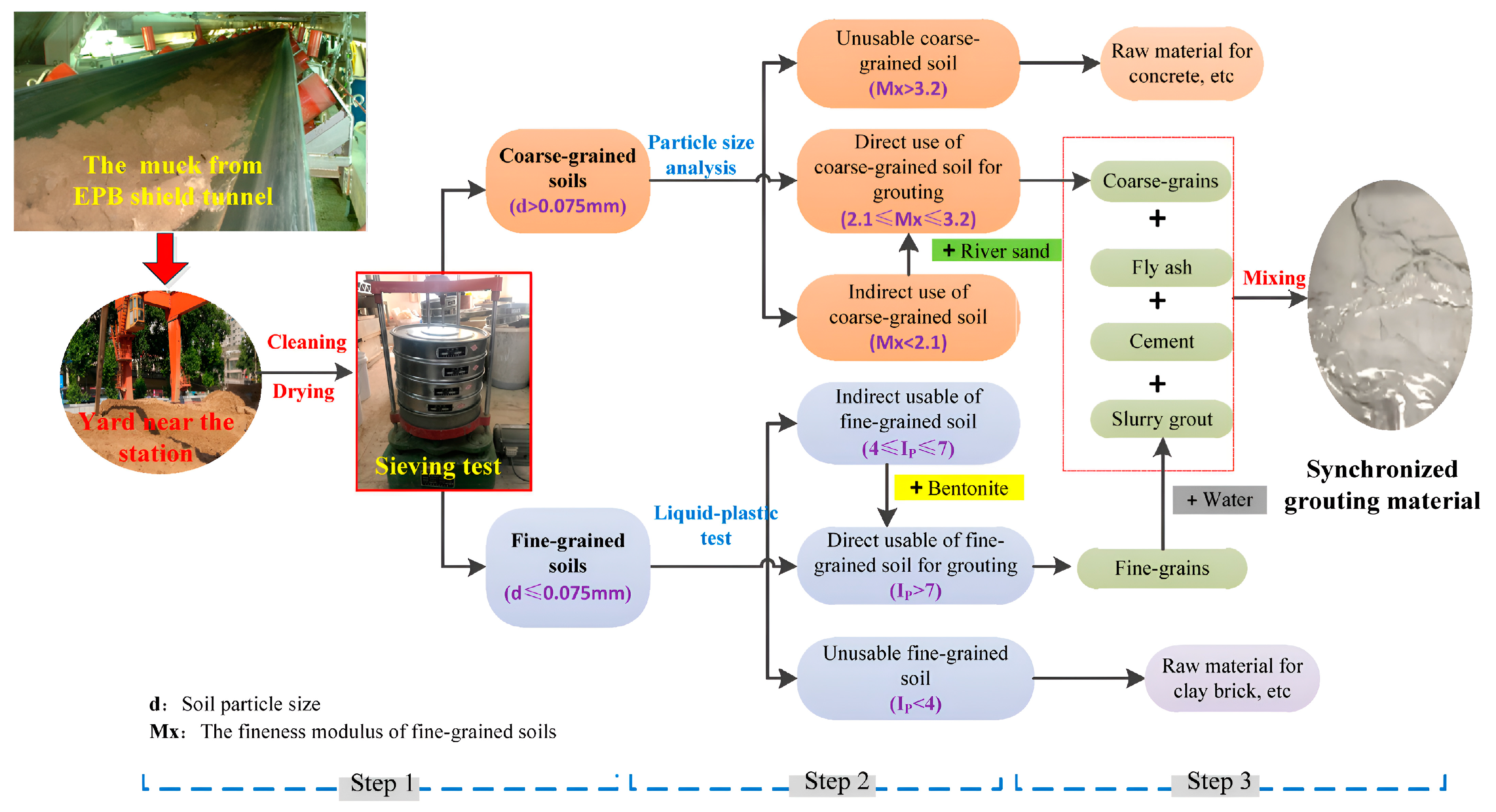

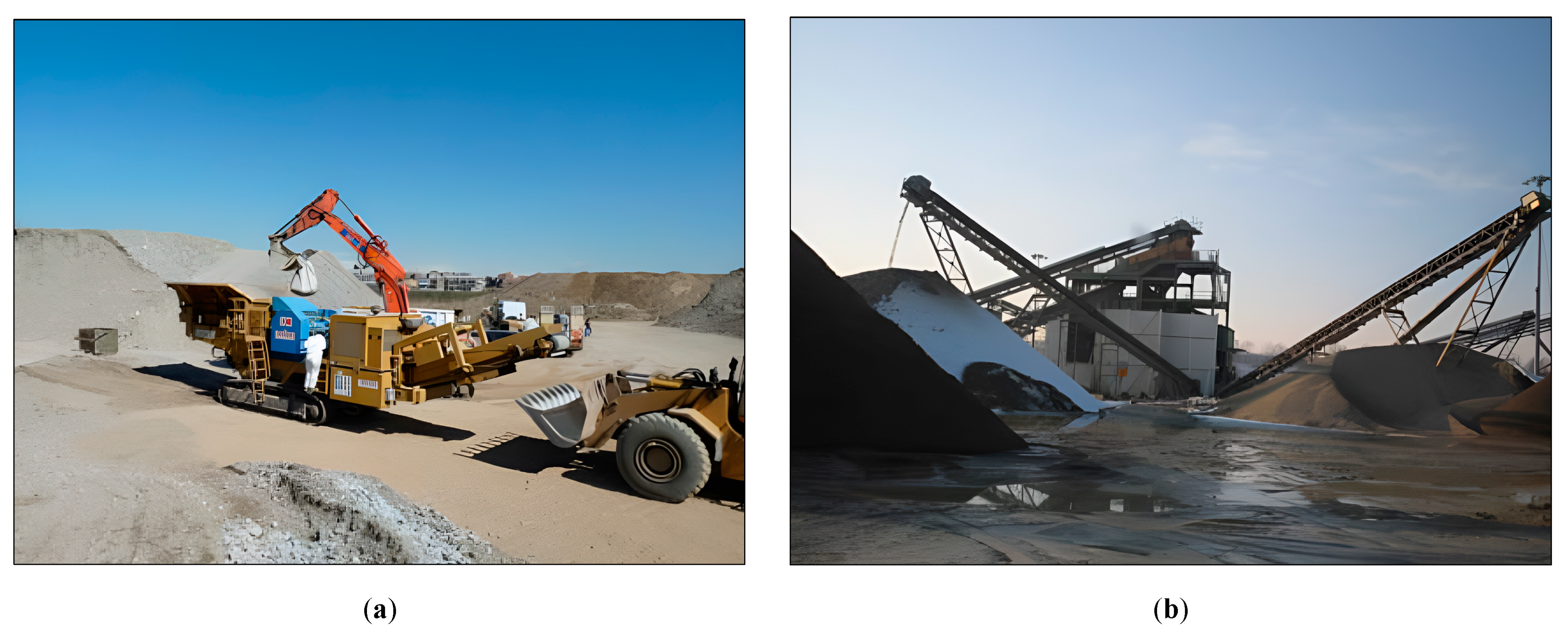

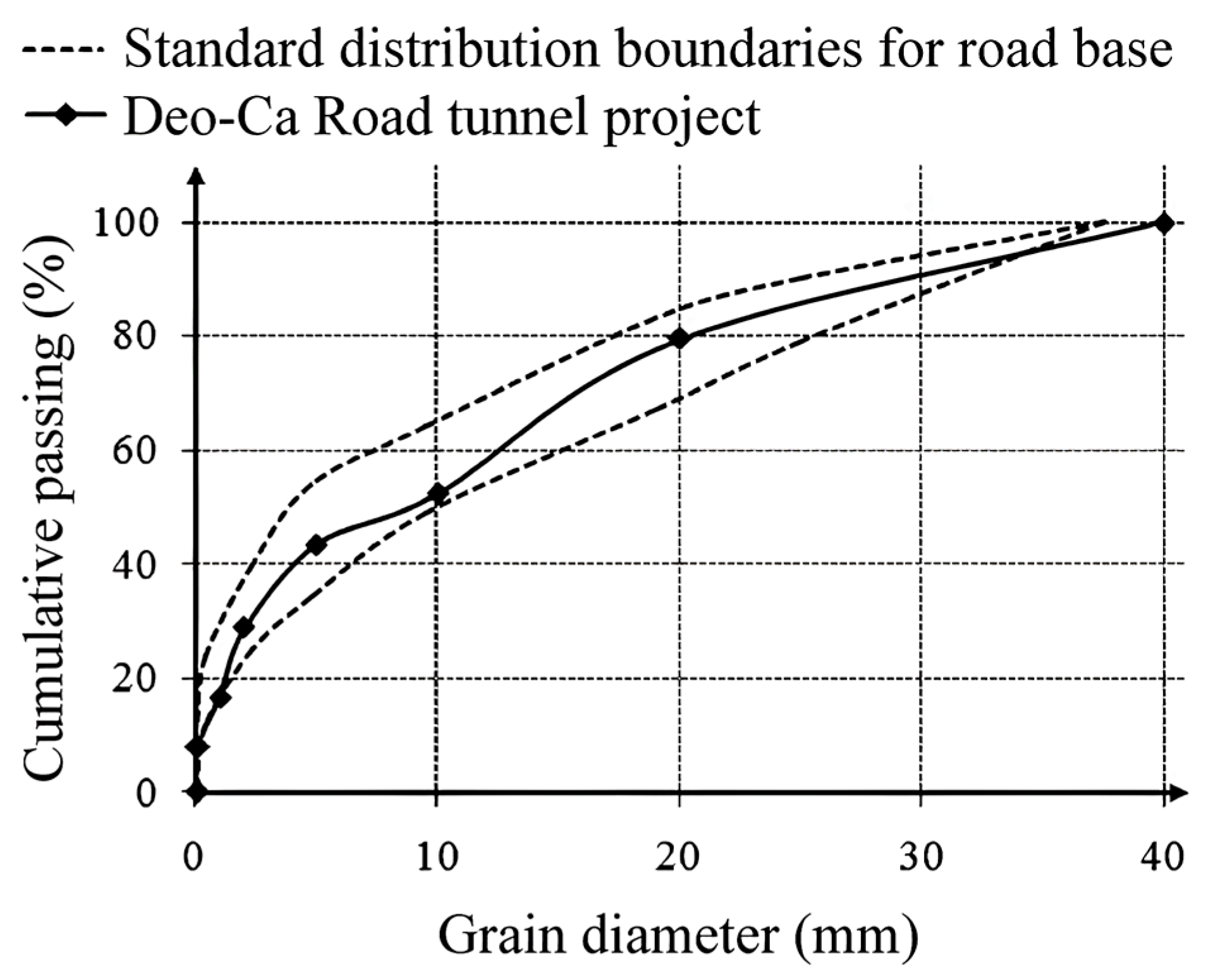
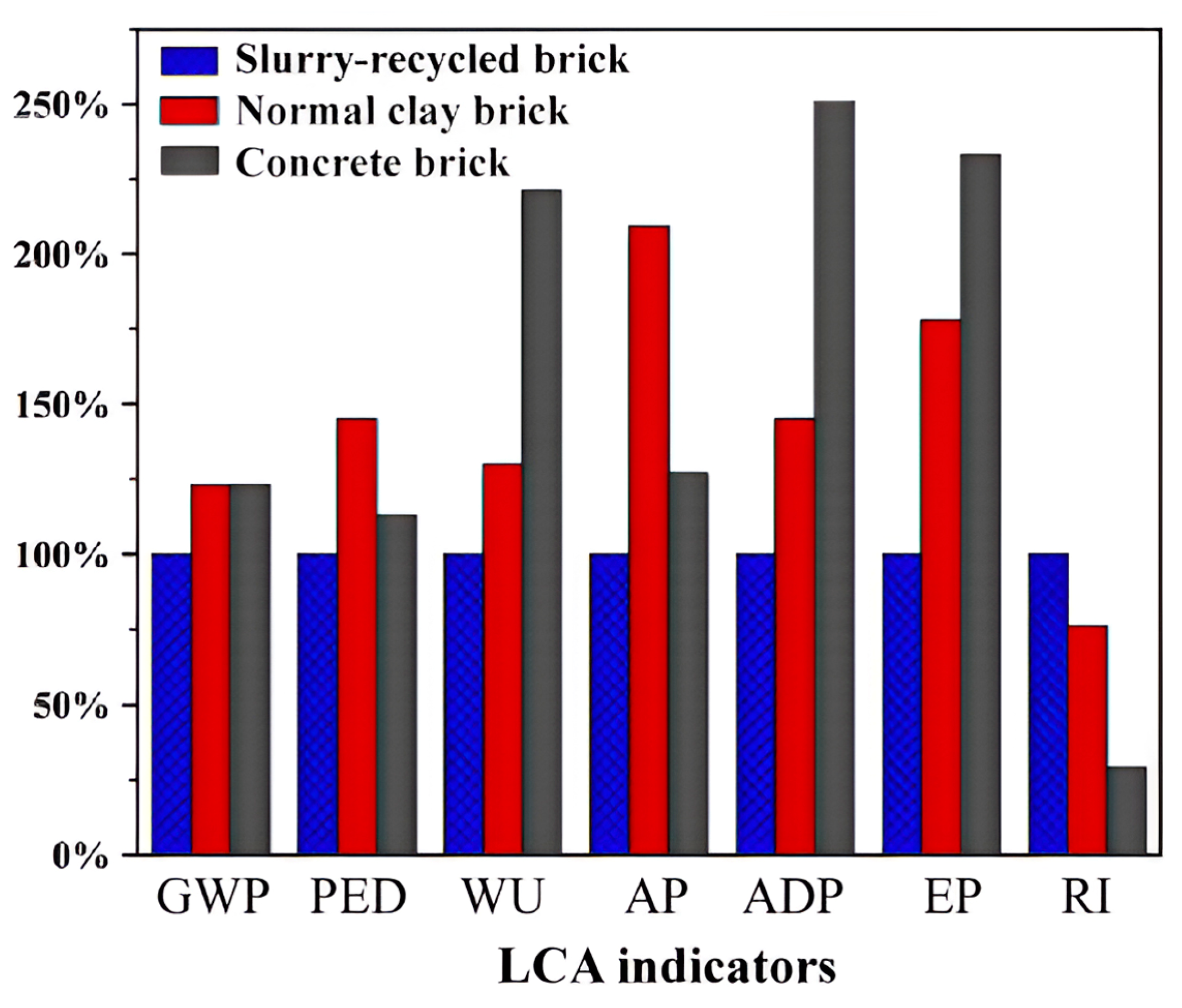





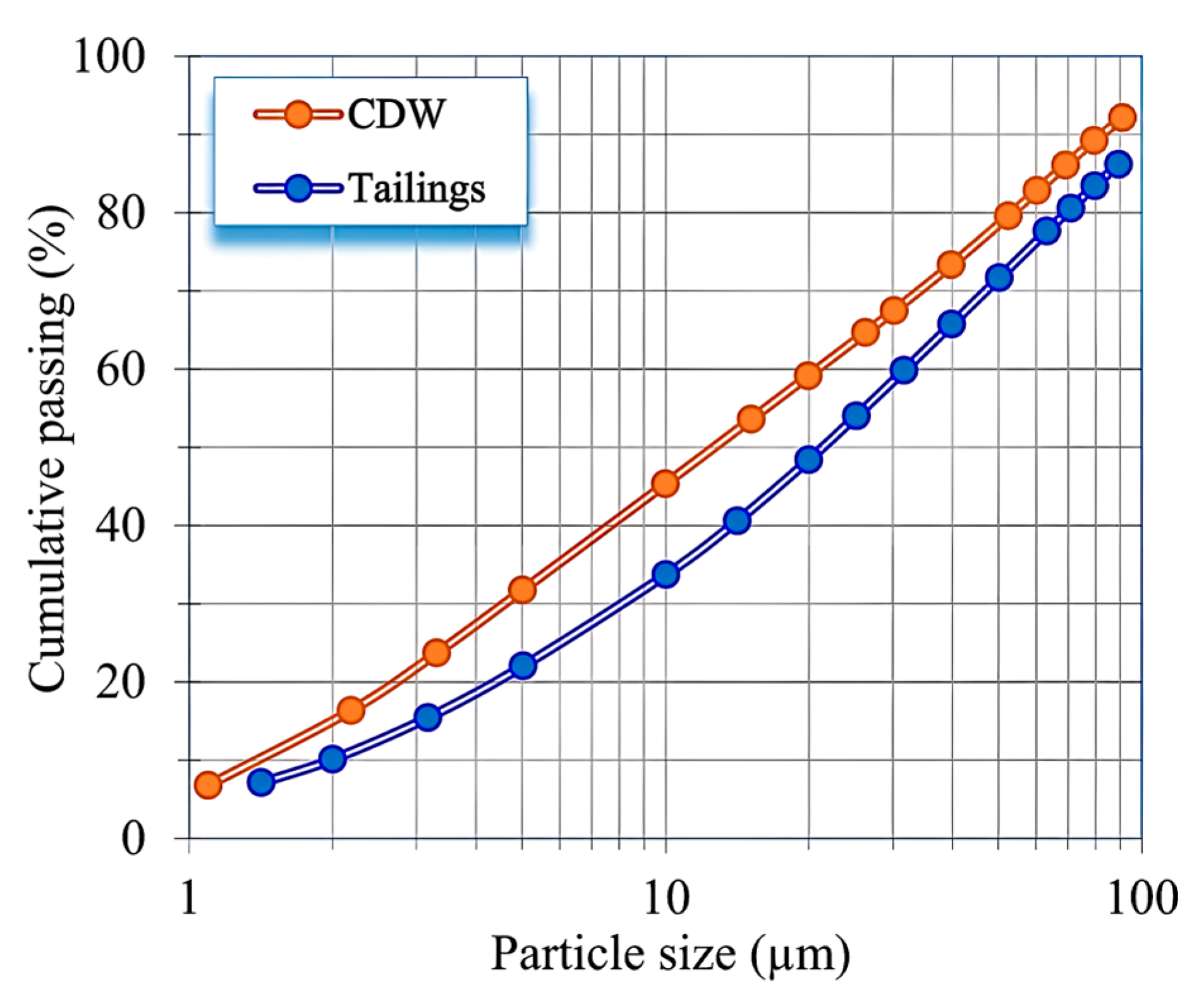

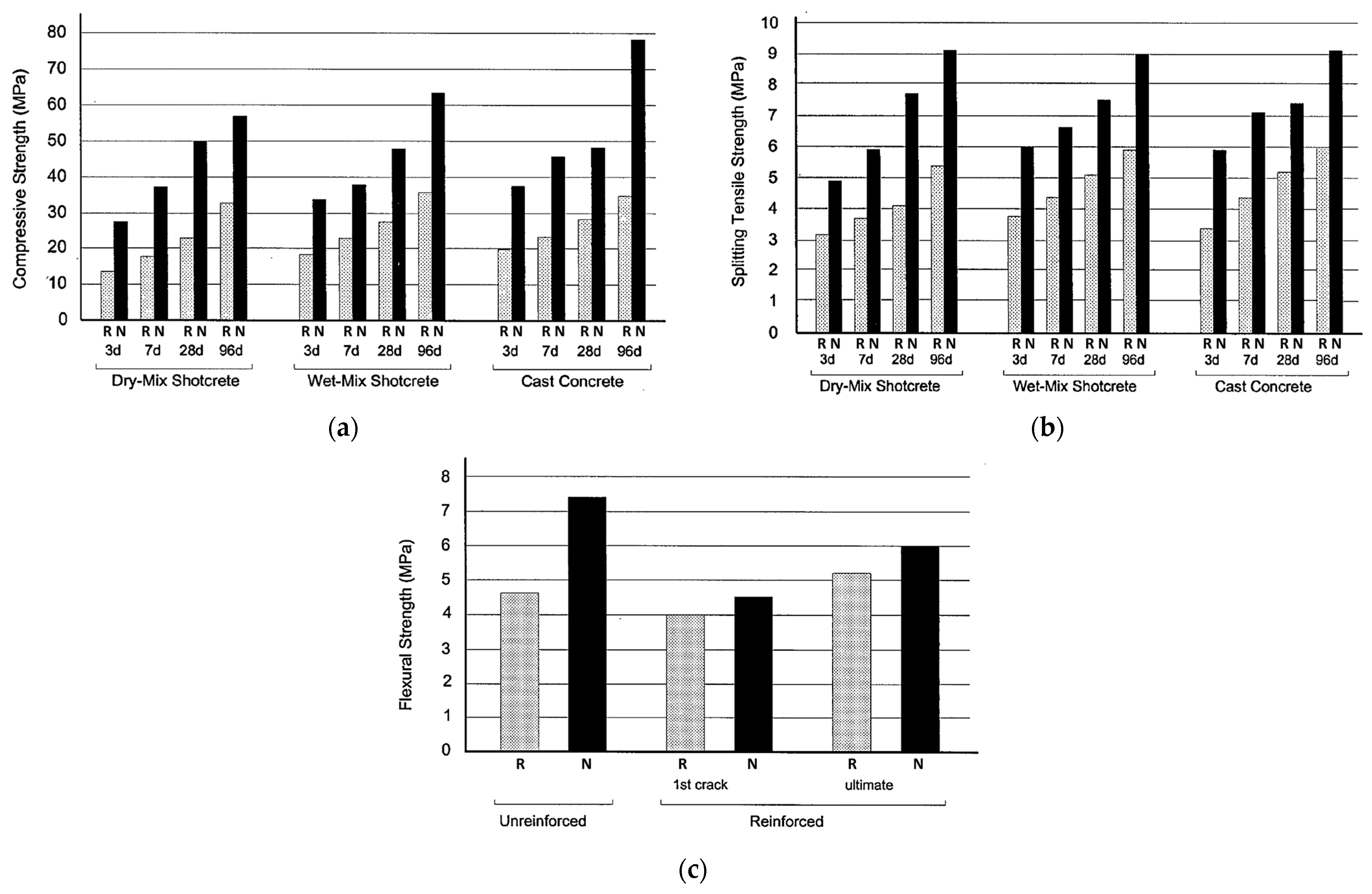
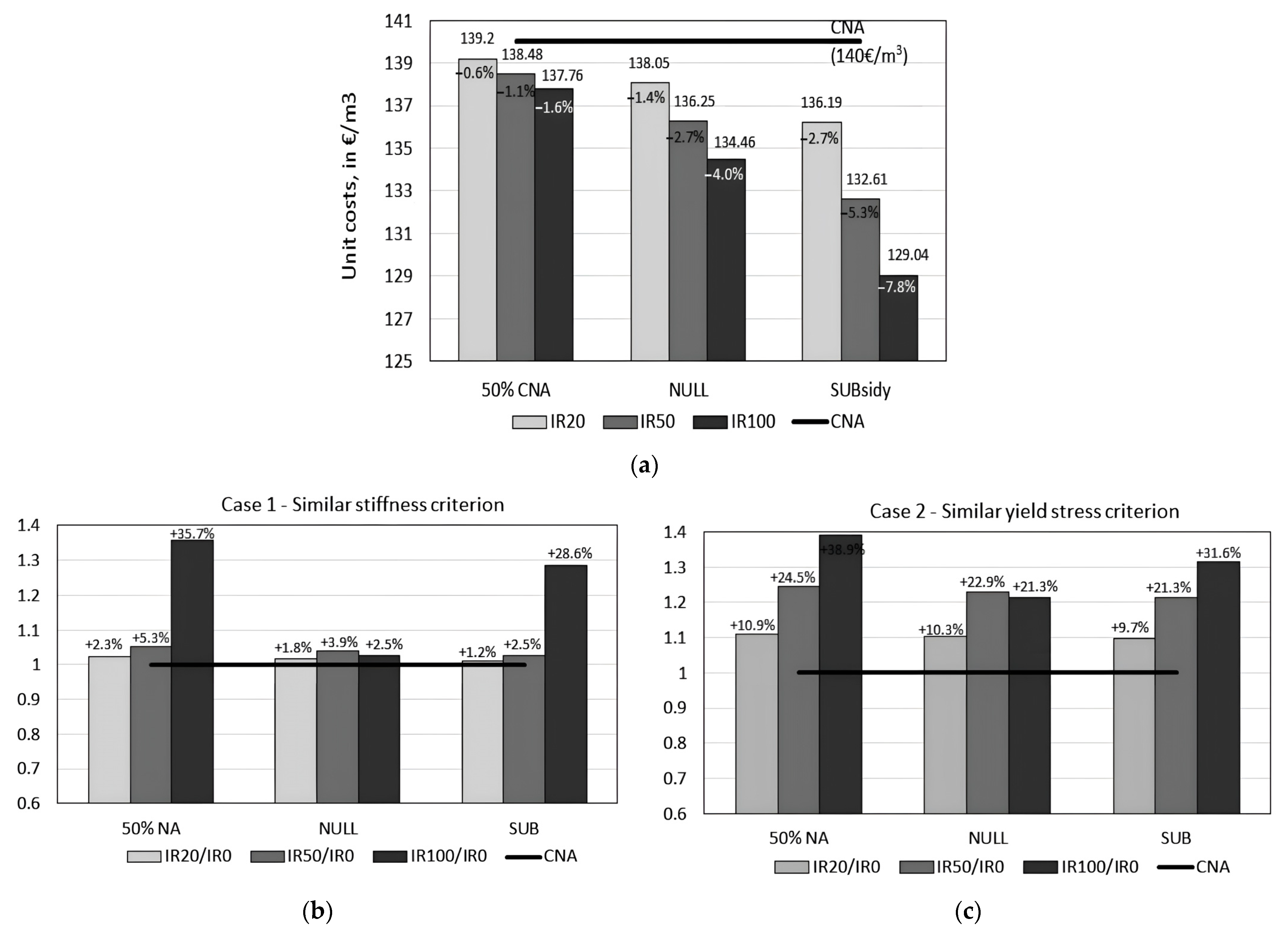
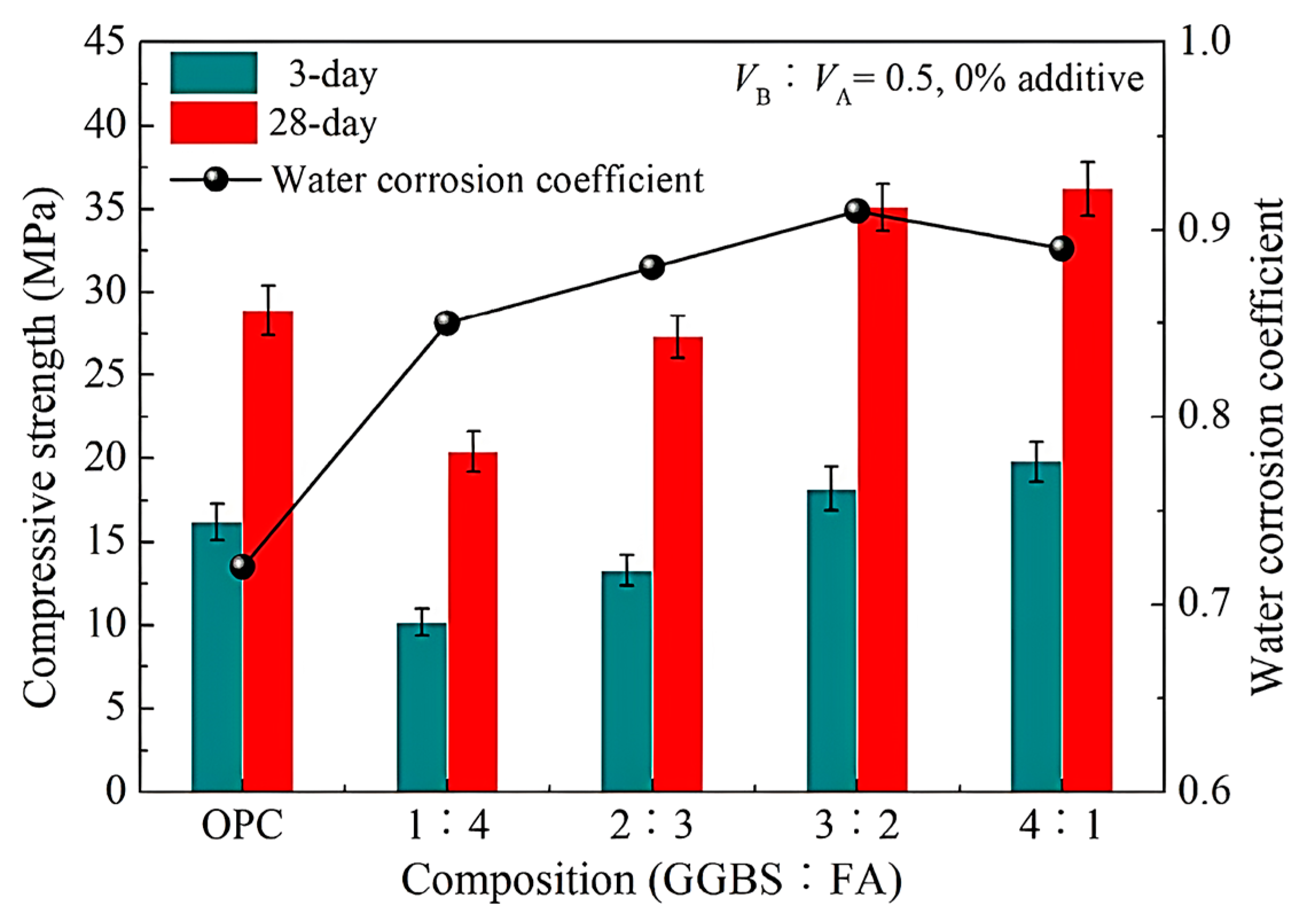

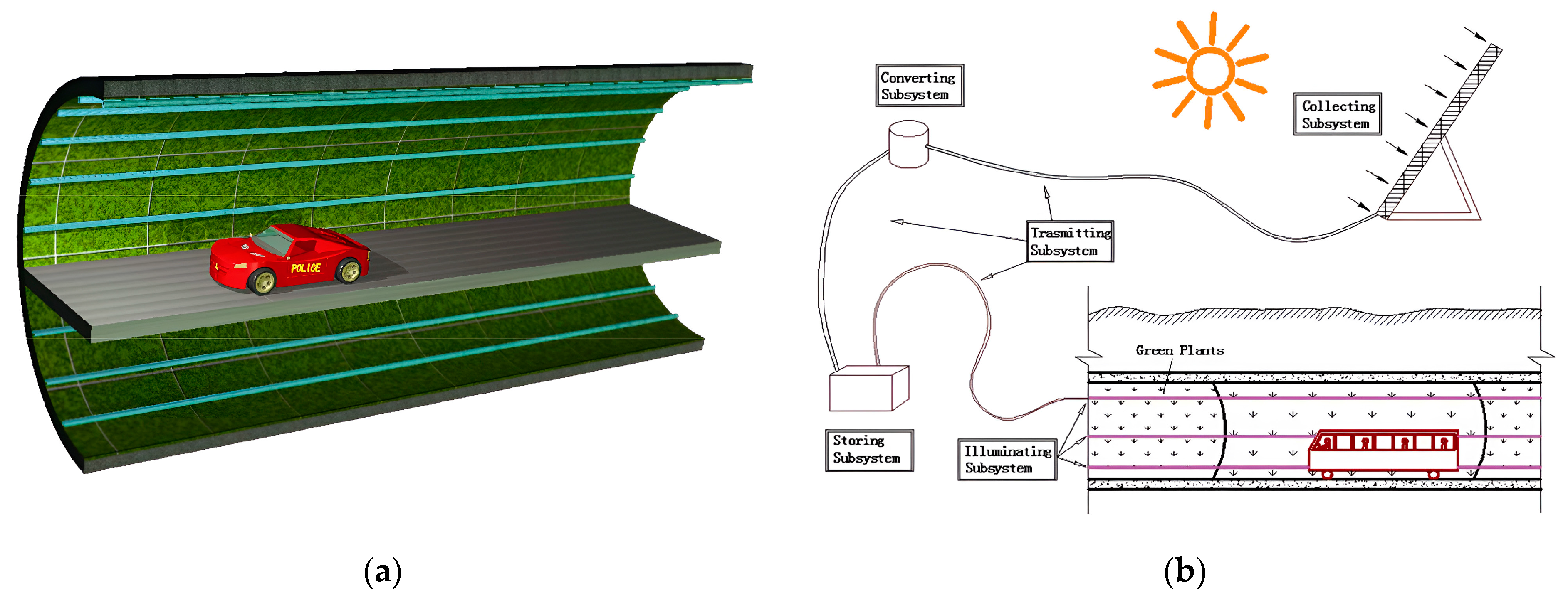


Disclaimer/Publisher’s Note: The statements, opinions and data contained in all publications are solely those of the individual author(s) and contributor(s) and not of MDPI and/or the editor(s). MDPI and/or the editor(s) disclaim responsibility for any injury to people or property resulting from any ideas, methods, instructions or products referred to in the content. |
© 2024 by the authors. Licensee MDPI, Basel, Switzerland. This article is an open access article distributed under the terms and conditions of the Creative Commons Attribution (CC BY) license (https://creativecommons.org/licenses/by/4.0/).
Share and Cite
Sharghi, M.; Jeong, H. The Potential of Recycling and Reusing Waste Materials in Underground Construction: A Review of Sustainable Practices and Challenges. Sustainability 2024, 16, 4889. https://doi.org/10.3390/su16124889
Sharghi M, Jeong H. The Potential of Recycling and Reusing Waste Materials in Underground Construction: A Review of Sustainable Practices and Challenges. Sustainability. 2024; 16(12):4889. https://doi.org/10.3390/su16124889
Chicago/Turabian StyleSharghi, Mohammad, and Hoyoung Jeong. 2024. "The Potential of Recycling and Reusing Waste Materials in Underground Construction: A Review of Sustainable Practices and Challenges" Sustainability 16, no. 12: 4889. https://doi.org/10.3390/su16124889
APA StyleSharghi, M., & Jeong, H. (2024). The Potential of Recycling and Reusing Waste Materials in Underground Construction: A Review of Sustainable Practices and Challenges. Sustainability, 16(12), 4889. https://doi.org/10.3390/su16124889





